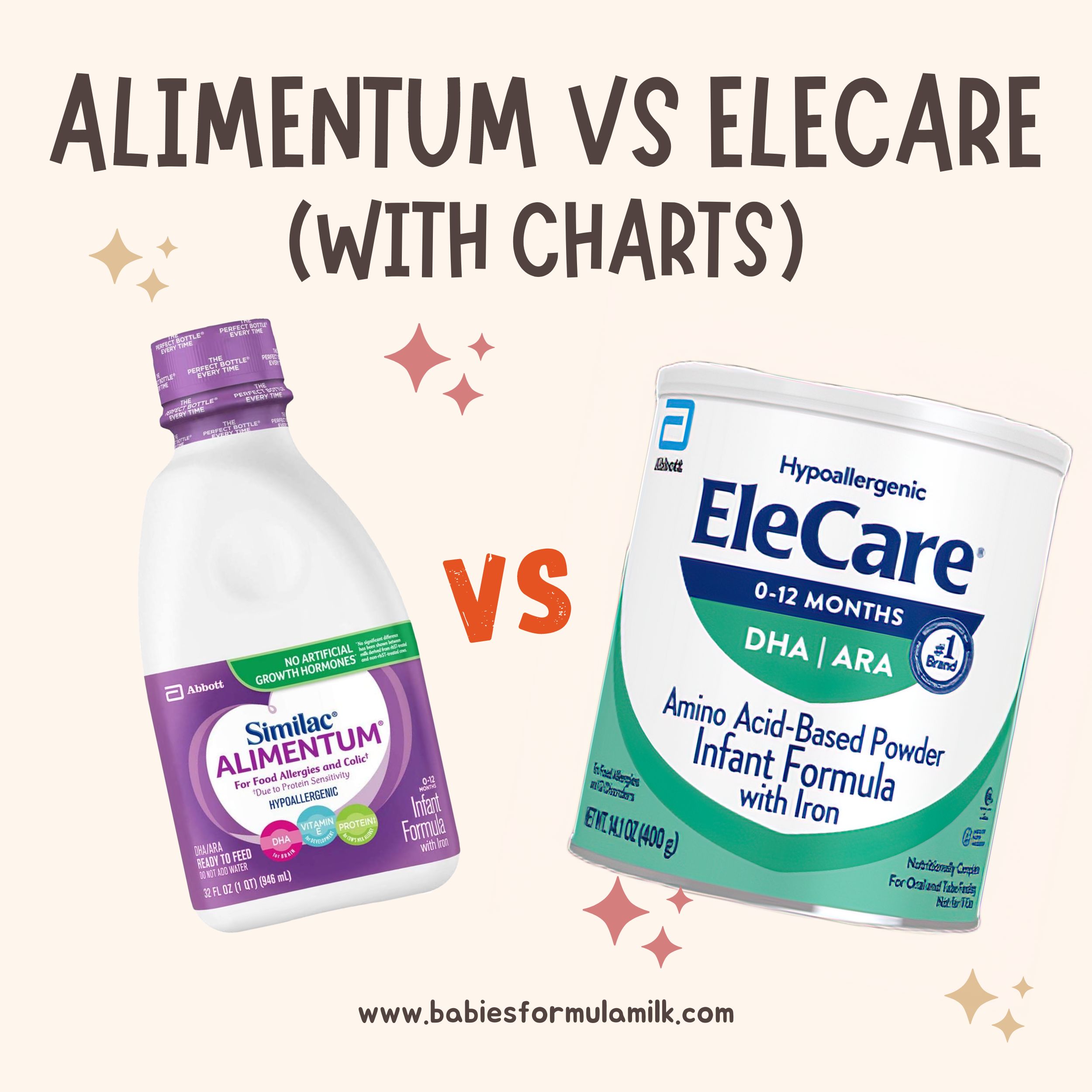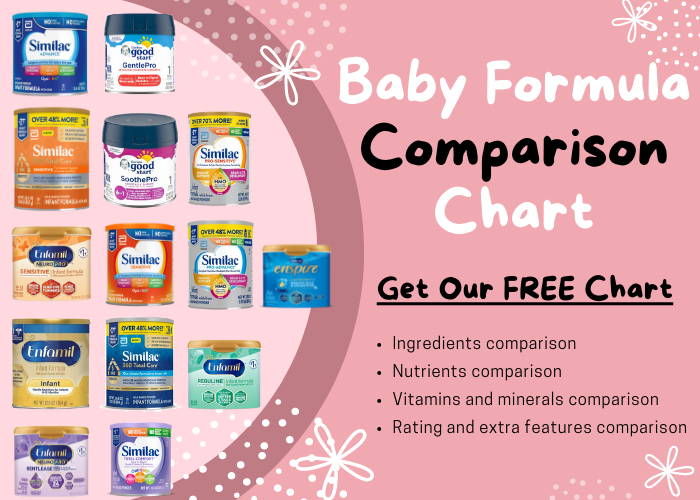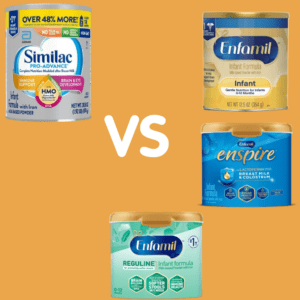Key Differences?
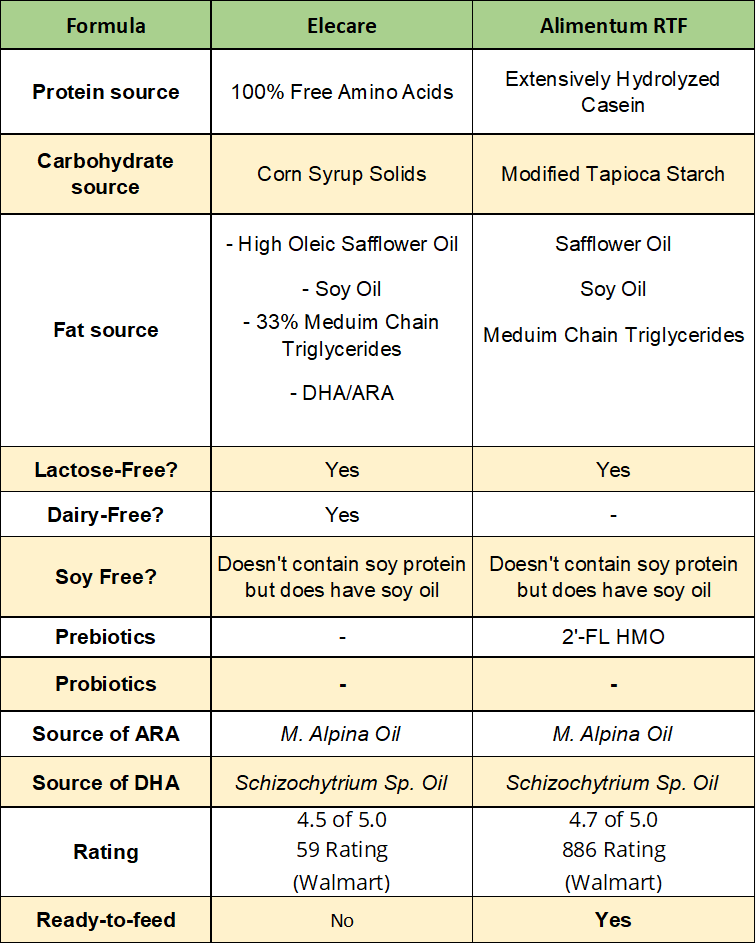
The Best One?
Choosing the best formula between Alimentum and Elecare depends on the baby’s specific dietary needs, allergies, and sensitivities.
Alimentum RTF is a cheap choice to relieve gas, spit-up, colic, and fussiness due to dairy and lactose allergies.
Elecare is highly praised for managing reflux, gas, and stomach issues in infants with severe food allergies, that extensively hydrolyzed formulas like Alimentum can’t fix, thanks to its free amino acid-based formula.
If the baby has severe food allergies or multiple sensitivities, Elecare’s highly hypoallergenic formula may be the better choice. However, for less severe sensitivities, Alimentum will be a suitable option.
Thus, start always with Alimentum if it doesn’t work switch to Elecare.
Mom’s Reviews Comparison:

Alimentum RTF and Elecare receive mixed reviews from moms based on their experiences with these specialized formulas.
Alimentum RTF earns praise for its effectiveness in reducing gas, spit-up, colic, and fussiness, making it an excellent choice for babies with sensitive stomachs. It is also commended for its user-friendliness, making life easier for busy moms.
However, some moms find it expensive, especially when compared to regular formulas, also it has a thicker consistency.
Traveling with Alimentum RTF can be hard as it needs to be refrigerated and is only good for 48 hours after opening. But, there are 2 oz bottles that will be good for traveling.
The taste may not be pleasant for some babies, making the transition from breast milk more challenging. Additionally, it may cause constipation in certain infants.
On the other hand, Elecare is highly regarded for its effectiveness in alleviating reflux, gas, and stomach issues, offering relief to babies with such problems. Its ease of mixing and digestion is appreciated by moms and ensures comfort for babies.
Nonetheless, Elecare’s price is a concern for some parents, it’s more expensive than Alimentum. The taste and smell of Elecare may also deter some babies from accepting the formula, Also it may lead to harder stools in some cases. Furthermore, the limited availability in stores makes it challenging for parents to find.
Related: Alimentum RTF Vs Neocate: Full Comparison (With Charts)
Ingredients Comparison:
Protein Source:
Alimentum RTF’s protein source is the extensively hydrolyzed casein. Casein is a type of protein found in cow’s milk. In the process of hydrolyzation, the protein molecules are broken down into smaller fragments. This partial breakdown makes the protein easier to digest for babies with sensitive stomachs or those who have difficulty processing intact cow’s milk proteins.
By breaking down the casein, Alimentum aims to reduce the likelihood of triggering allergic reactions in infants with cow’s milk protein allergies or lactose intolerance. The smaller protein fragments are gentler on the digestive system, making Alimentum a suitable option for babies with such dietary challenges.
On the other hand, Elecare’s protein source is made up of free amino acids. Amino acids are the basic building blocks of proteins. Unlike Alimentum, which uses extensively hydrolyzed casein, Elecare completely bypasses the need for digestion by providing the proteins in their simplest form – free amino acids.
Related: Alimentum RTF Vs Puramino: Mom’s Reviews – Ingredients – Prices
This unique approach makes Elecare highly hypoallergenic since it contains no intact cow’s milk or soy proteins that could potentially trigger allergic reactions in infants. Instead, the formula provides all the necessary amino acids directly, ensuring easy absorption and minimal stress on the digestive system. This makes Elecare an ideal option for babies with severe food allergies, multiple food protein intolerances, or those who can’t tolerate extensively hydrolyzed formulas.
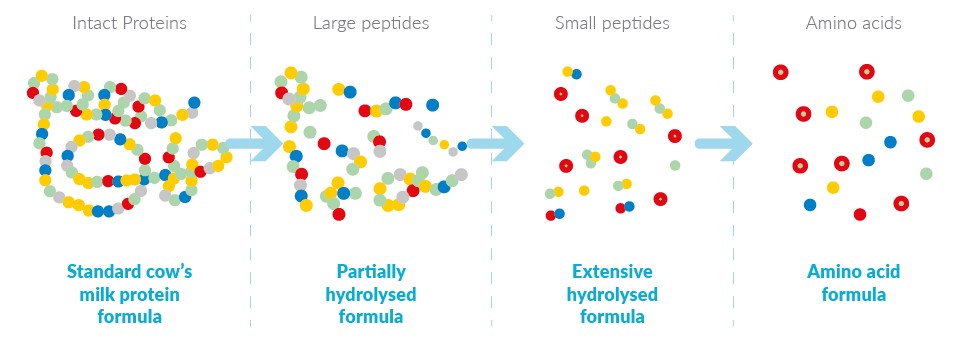
Carbohydrate Source:
Alimentum RTF’s carbohydrate source is modified tapioca starch. Tapioca starch is derived from the cassava root and is processed to create a thickening agent. In Alimentum RTF, modified tapioca starch is used as a carbohydrate source, providing energy for the baby.
On the other hand, Elecare’s carbohydrate source is corn syrup solids. Corn syrup solids are made from corn starch and undergo processing to create a concentrated form of sugar. In Elecare, corn syrup solids serve as the primary source of carbohydrates, supplying the necessary energy for the baby’s growth and development.
Related: EleCare Vs Neocate: Full Comparison (With Charts)
Fat Source:
Alimentum RTF’s fat source includes a combination of safflower oil, soy oil, and medium-chain triglycerides. Safflower oil and soy oil are vegetable oils that provide essential fatty acids for a baby’s growth and development. Medium-chain triglycerides (MCTs) are special fats that are easier to absorb and digest, making them beneficial for infants with sensitive digestive systems.
On the other hand, Elecare uses high oleic safflower oil, soy oil, and medium-chain triglycerides in its fat source. High oleic safflower oil is a variation of safflower oil with higher levels of oleic acid, a monounsaturated fat known for its heart-healthy benefits. The inclusion of MCTs in Elecare’s formula also helps facilitate easier digestion and absorption of fats.
33% of Elecare and Alimentum’s fat source is from medium-chain triglycerides.
Prebiotics:
The 2FL HMO prebiotic found in Alimentum ready-to-feed is a significant component that sets this formula apart. HMO stands for human milk oligosaccharides, which are complex carbohydrates naturally found in breast milk. Among the various HMOs, 2FL (2′-fucosyllactose) is one of the most abundant and widely researched.
2FL HMO serves as a prebiotic, which means it acts as food for beneficial bacteria in the baby’s gut. Prebiotics help support the growth and activity of these friendly bacteria, known as probiotics, which play a vital role in maintaining a healthy gut environment. A well-balanced gut microbiota is essential for the baby’s overall health and proper immune system development.
By including 2FL HMO in Alimentum ready-to-feed, the formula aims to mimic the benefits of breast milk further.
On the other hand, Elecare doesn’t have a prebiotic.
Related: Alimentum RTF Vs Alfamino: Which One To Choose?
Nutrition Comparison:
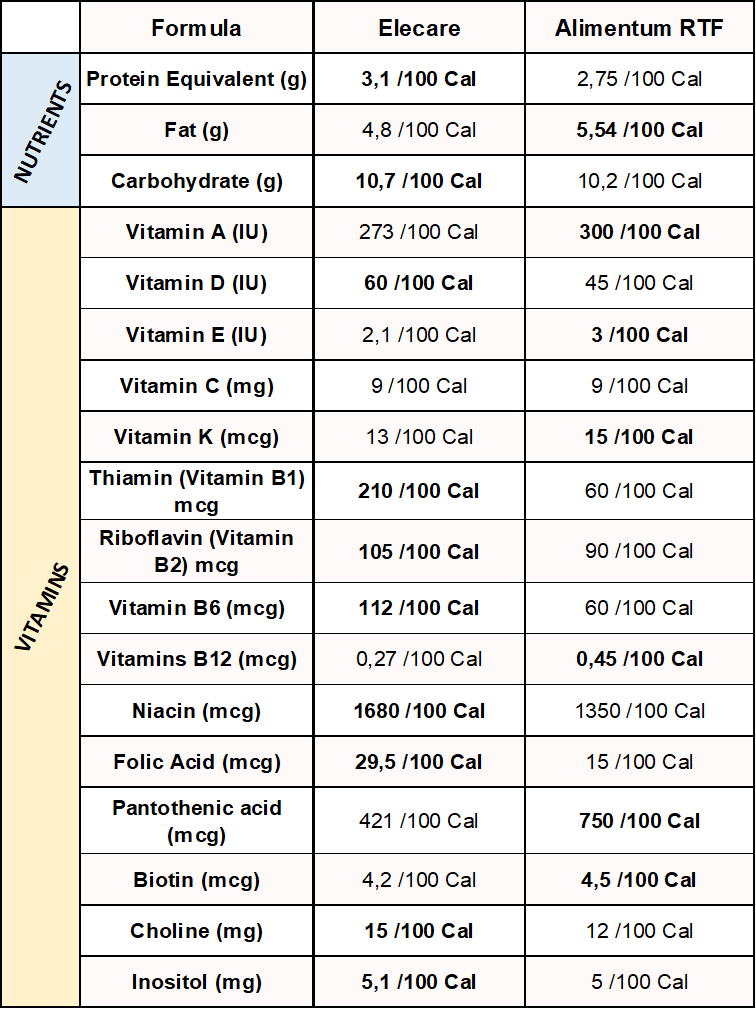
Nutrients:
When comparing Alimentum and Elecare in terms of nutrients, a few notable differences emerge. Elecare offers a higher protein equivalent at 3.1 grams per 100 calories, while Alimentum provides 2.75 grams per 100 calories. This makes Elecare slightly richer in protein content compared to Alimentum.
In terms of fat, Alimentum contains 5.54 grams per 100 calories, whereas Elecare has 4.8 grams per 100 calories. Here, Alimentum has a slightly higher fat content than Elecare.
Regarding carbohydrates, Alimentum provides 10.2 grams per 100 calories, while Elecare offers 10.7 grams per 100 calories. This makes Elecare marginally higher in carbohydrate content compared to Alimentum.
Overall, the differences in nutrient content between Alimentum and Elecare are relatively small. Both formulas are designed to provide essential nutrients for infant growth and development.
Related: Elecare Vs Alfamino: Full Comparison (With Charts)
Vitamins:
In terms of vitamins, Elecare has been enriched more with Vitamin D, Vitamin B1, Vitamin B2, Vitamin B6, Niacin, Folic Acid, and Choline Acid whereas Alimentum is fortified more with Vitamin A, Vitamin E, Vitamin K, Vitamin B12, Pantothenic Acid, and Biotin.
However, Both formulas have the same vitamin levels of Vitamin C and Inositol.
Minerals:

In terms of minerals and as the table above shows, Elecare is enriched with mineral levels more than Alimentum except for Iron and Chloride.
“Chromium is essential for maintaining normal glucose metabolism,” says pubmed.ncbi.nlm.nih.gov
“Molybdenum works in the body to break down proteins and other substances,” says WebMD
Price and Size Comparison:
| ALIMENTUM | ELECARE |
|---|---|
| 34.84 $ 12.1 oz 2.88 /oz Buy HERE | 44.97 $ 14.1 oz 3.19 /oz Buy HERE |
| 12.79 $ 32 fl oz 40 ¢/fl oz Buy HERE at Walgreens 13.12 $ 32 fl oz 41 ¢/fl oz Buy HERE at Walmart | – |
Switching From Alimentum to Elecare:
Is it Safe?
Yes, it is safe to switch from Alimentum to Elecare as Elecare is considered more hypoallergenic. If the baby did not respond well to Alimentum, the next logical step is to consider amino acid-based formulas like Elecare.
Before making the switch to Elecare, it might be worthwhile to try other hypoallergenic formulas like Nutramigen and Gerber Extensive HA. These options could be explored as they are less expensive than amino acid-based formulas and may still provide relief for the baby’s sensitivities.
Related: The Best Generic Alimentum Formula (Tested by Moms)
How to Switch From Alimentum to Elecare?
Switching from Alimentum to Elecare requires careful consideration and a gradual transition to help the baby adapt to the new formula effectively. Here’s a step-by-step guide on how to make the switch:
- Introduce Small Amounts of Elecare: Start by introducing small amounts of Elecare alongside the usual Alimentum feedings. Begin with mixing a small portion of Elecare with Alimentum in the baby’s bottle. By taking this gradual approach, the baby’s digestive system can adjust to the new formula step by step.
- Monitor Baby’s Response: Pay close attention to how the baby responds to the introduction of Elecare. Observe for any signs of discomfort, allergic reactions, or digestive issues. If any adverse reactions occur, consult your pediatrician immediately.
- Increase Elecare Proportion: Gradually increase the proportion of Elecare in the bottle over several days or weeks, depending on how well the baby tolerates the change. Continue monitoring for any adverse reactions during this process.
- Full Transition: Once the baby shows a positive response to Elecare and is comfortably tolerating the new formula, complete the transition by exclusively feeding them with Elecare.
- Be Patient: Keep in mind that transitioning to a new formula may take time. Some babies adjust quickly, while others may need more time to adapt. Be patient throughout the process and trust your baby’s cues.
- Follow Mixing Instructions: When preparing the Elecare formula, carefully follow the mixing instructions provided on the product packaging. Accurate measurements are essential to ensure the baby receives the proper nutrition.
- Seek Support: If you encounter any challenges or have questions during the transition, don’t hesitate to seek support from your pediatrician or a registered dietitian who specializes in infant nutrition.
Remember, every baby is different, and individual responses to formula changes can vary. Taking a gradual approach and seeking professional guidance will help ensure a smooth and successful transition from Alimentum to Elecare.

